Textiles and Dress Designing - Elements of Design | 12th Textiles and Dress Designing : Chapter 6 : Designing of Clothing
Chapter: 12th Textiles and Dress Designing : Chapter 6 : Designing of Clothing
Elements of Design
Elements of Design
The elements are the fundamentals of a design. These form the
basic structure of a design conveying wide range of messages. It is very
important for a designer to understand design elements as it finds its
application in various fields like interior decoration, fashion designing,
architecture, vegetable carving and visual arts. The basic elements of design
are line, shape, form, colour and texture.
1. Line
Line is defined as an indication that gives a distance between two
points. It is one of the most basic elements in art and design. Line is a mark
made by the media such as brush, pencil, stick, pen, charcoal and paint. Lines
are found everywhere as these are used in forming words, numbers and symbols.
Line exists in nature as a structural feature. For example, lines on zebra,
branch of a tree, mountain peaks, weaves and thunder (Figure 6.8).
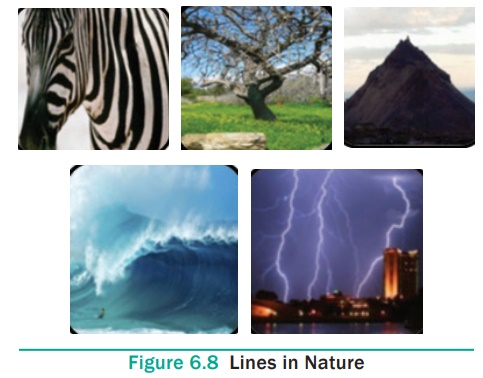
It also defines mass and volume. It may be continuous or
discontinuous.
Types of Lines
The lines may be classified based on the curves introduced or
continuity. (Figure6.9 and Table 6.1)
a) Based on Curves
A. Straight Lines
These lines are very rigid, structural and formal in nature. They
depict masculinity in designs. Straight lines are forceful leading the eye to
the focal point. Example: Landscape designs (coconut trees). These are more
suitable for male garments.
B. Curved Lines
These are more pleasing to the eyes. These are soft and depict
femininity in designs. Curved lines are informal, and relaxed in nature. These
are more suitable for female garments.
C. Zigzag Lines
A zigzag line is an angular shape characterized by sharp turns in
alternating directions. These lines have short sharp turns and angles. It is
said to be a tracing a path between two parallel lines.
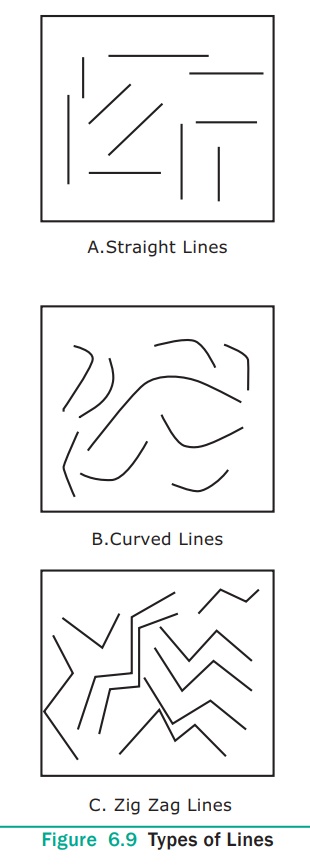
All these types of lines may be continuous or discontinuous.
b) Based on Continuity
Lines are divided into two based on its continuity as continuous
and discontinuous lines (Figure 6.10).
1. Continuous Lines
When the lines are drawn continuously these are called continuous
lines.
2. Discontinuous Lines
These lines are broken and drawn without continuity.
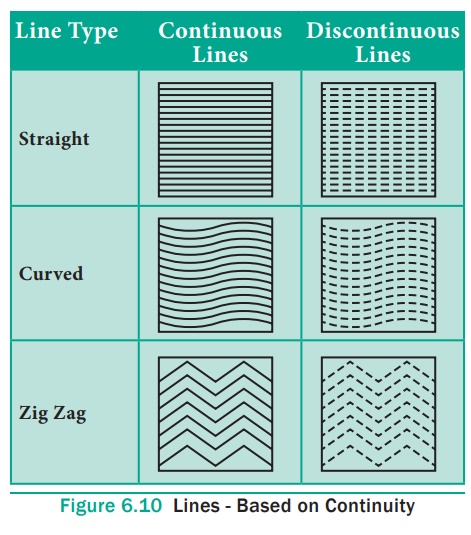
c) Based on Direction
The lines may be either in the silhouette or in the decoration of
a garment. The lines are applied on the garments as given below (Figure 6.11).
Horizontal Lines
The horizontal lines suggest a feeling of restful, relaxing and
almost peaceful response. These lines move width wise on an object. These lines
have a tendency of creating illusions as if the garment is shorter and larger.
Vertical Lines
These lines run erect from up to down on a garment. These lines
give an illusion as if the garment is taller and narrower. These create a sense
of stability.
Diagonal Lines
These lines are neither horizontal nor vertical but run in a diagonal manner with an angle. These lines suggest a feeling of movement or direction. These lines give an illusion of more depth and space. On garments diagonal lines should be combined with vertical or horizontal lines for better effect. But if they are used alone for the entire garment, it gives a disturbing effect.
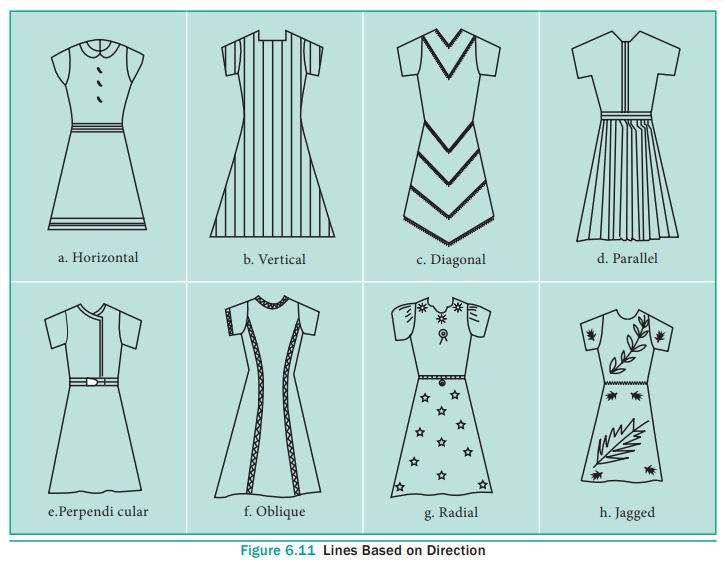
Parallel Lines
These lines in the design run along each other with equal distance
in between them.
Perpendicular Lines
These lines in the design run at 90 degrees to each other. One
line is in vertical and the other line is in horizontal manner.
Oblique Lines
These lines in the design run in a slanting manner.
Radial Lines
These lines in the design run in a circular manner.
Jagged lines
Jagged lines are not in order and these give a feeling of anger
and disorder.
d) Based on the Measure
They are thick, thin, short, long, tapering and uneven. The lines
are drawn with various depths as required to complete a figure. Few examples
for the measure variations are given below on a garment (Figure 6.12).
a. Thick – This line in the design is fat and bold.
b. Thin – This line is thin forming the design.
c. Short – This line in the design is short.
d. Long – This line is very long in the design.
e. Tapering – This type of line taper towards the end. The initial
portion is broader and it narrows towards the end.
f. Uneven – This line is uneven
throughout the design. It is quite disturbing.

e) Based on the Character- sharp, blurry, fuzzy, choppy, graceful and smooth. (Figure 6.13).
a. Sharp – The lines are pointed.
b. Blurry – The lines are blurred and unclear.
c. Fuzzy – The lines are hairy and blurry.
d. Graceful – The lines are elegant and stylish.
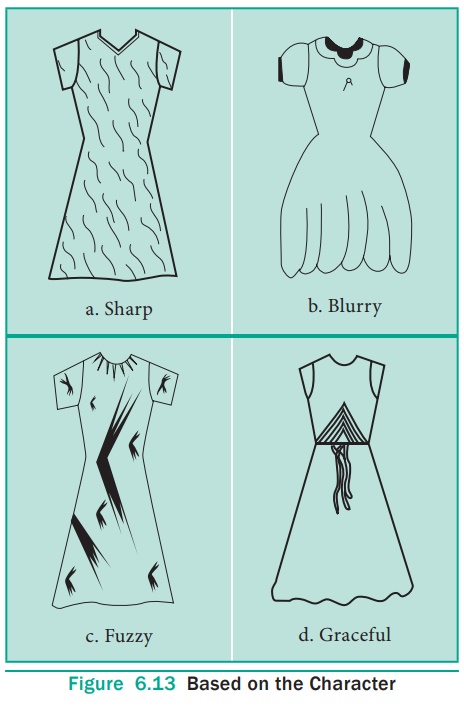

2. Shape and Form
Shape
A specific configuration of the line or plane in 2-dimension is
defined as shape, that separates a form from the background space. Shapes of
clothing determine the outer shape of a person, as shape describes the outer
dimensions of an object. The silhouette creates an impression about the person.
The shape in a garment is either structural or decorative in nature. The shapes
of garment may be modified in different ways. The shapes are introduced in
garment through features such as bodice, skirt, sleeve, collar and yoke. When
lines are joined to enclose space, they result in an outline joined to enclose
a contour or shape. The garment shapes which could be applied for enhancing the
comfort and beauty are expressed under.
Geometric Shapes
The 3 distinct types of geometric shpes are rectilinear –
square or rectangle, angular – triangle or pyramid and curvilinear
– circle, sphere cone and cylinder. Geometric shapes are structured and often
symmetrical. Rectangle, trapezoids and parallelograms are modified squares. An
oval shape is an elongated circle and pentagons, octagons and hexagons are
created with a combination of rectangles and triangles. (Figure 6.14).
Rectangle
Opposite sides of this shape are equal. Styles with these lines
are slenderizing and suitable for the well proportioned, heavier women. It is
influenced by three factors namely shape, size and position. The examples for a
rectangular shape are garments with long, straight, hanging in loose, graceful
folds.
Triangle
Triangular shape is three sided. It may be formed also in an
inverted position in the garments. It contributes unity and balance to the
garments as it is stable. Examples are garments with wide shoulders, narrow
skirt, dolman or raglan sleeves are good fashion design styles for large bust.
Square
A square has all sides equal. It gives visual clarity due to its
regularity. Examples are garments with straight or boat shaped neckline, boxy
jackets and capes. Generally this style is very good for the very thin figured
women, however, with proportions well planned and good design fabric can
camouflage various figure irregularities.
Round
The round shapes are suitable for formal wear or afternoon frocks.
This design in fashion garments is the most attractive on the very young and
the very thin figure. Examples for this shape are wide, crinoline lined skirts,
petal shapes and puffed sleeves.
Hourglass
Hourglass shape is natural and gives smooth fit over hips and full
skirt at bottom. It also gives a very good appearance for the tall, thin
figure. Examples: wide shoulders and leg of mutton sleeves.
Oval
This shape is good for well proportioned, ideal figure. It is
suitable especially for afternoon and evening wears.
Examples: draped and softly molded, very feminine and decorative
garments.
Circles
This shape is useful and compact. It represents unity, continuity
and economy.
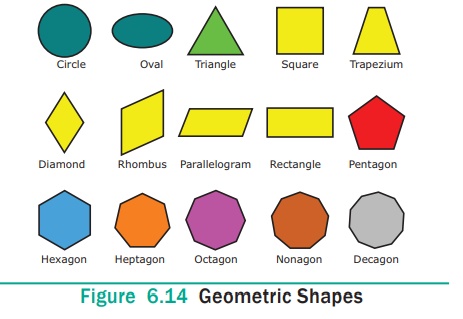
Natural Shapes
Natural shapes are shapes that are found in nature, and some
shapes are made by man also. Some examples of natural shapes are leaves and
puddles.
Abstract Shapes
Abstract shapes are those which are identifiable and are not real
in the same way that natural shapes are, Example; A stick – figure drawing of
an animal, alphabet graphs, icons and symbols can express an abstract shape
(Figure 6.14).
Related Topics